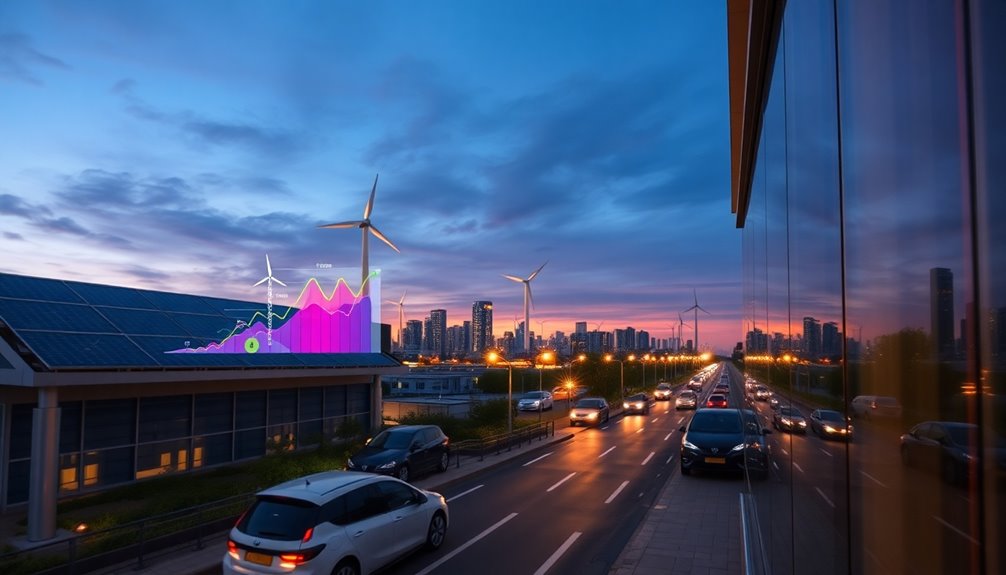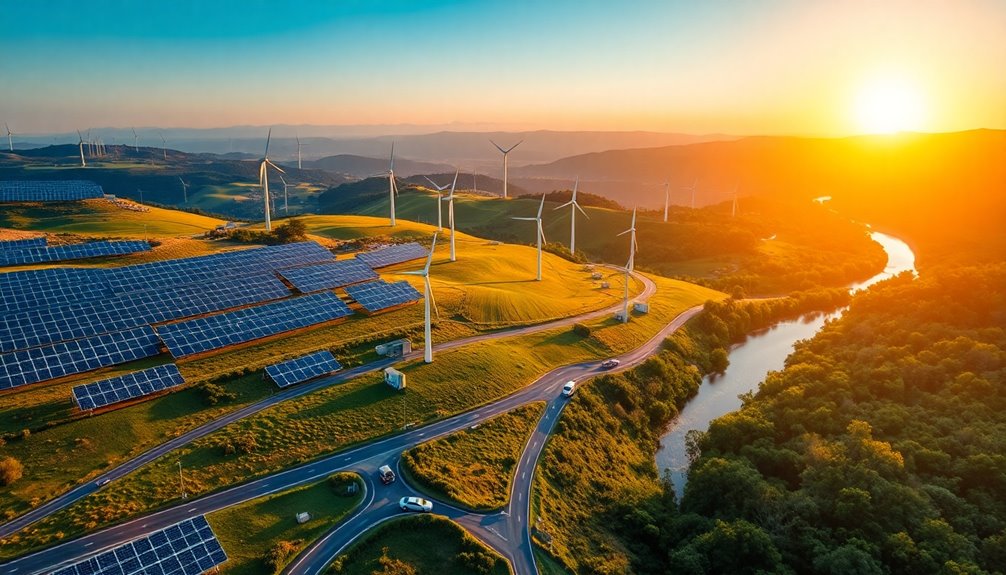Decarbonization pathways are shaped through integrated energy modeling, connecting various sectors like energy and transport. You'll see how sector coupling boosts decarbonization efforts, while life-cycle emissions assessments highlight areas for improvement. V2G integration offers innovative ways to stabilize the grid and utilize electric vehicles as energy storage. Together, these elements create a flexible, efficient energy system. Discover how they all work in harmony to achieve sustainability goals.
Key Takeaways
- Integrated energy modeling optimizes energy systems across sectors, identifying pathways to achieve decarbonization targets effectively.
- Sector coupling enhances decarbonization by integrating energy, transport, and industry sectors, leveraging renewable resources efficiently.
- Life-cycle emissions analysis provides a comprehensive view of environmental impacts, guiding targeted decarbonization strategies throughout production and consumption processes.
- Vehicle-to-grid integration allows electric vehicles to support grid stability and energy storage, reducing peak demand and enhancing overall system flexibility.
- Advanced modeling tools, such as HELICS, are critical for assessing multi-energy systems and maximizing the potential of decarbonization initiatives.

As you explore the challenges of decarbonization, integrated energy modeling emerges as a powerful tool that tackles energy issues holistically. This approach simulates energy systems together, optimizing energy use across various sectors like electricity, cooling, and transportation. By co-optimizing these systems, you can identify pathways that not only meet sustainability goals but also enhance overall efficiency.
Tools like HELICS facilitate combined cyber and physical domain simulations, which are essential for assessing multi-energy systems and their role in decarbonization.
One key element of effective decarbonization modeling is sector coupling. Integrating different sectors—energy, transport, and industry—enables you to enhance decarbonization efforts significantly. By modeling these couplings, you can discover optimal pathways that leverage renewable energy sources efficiently across sectors. Furthermore, scenario analysis is a common method used in integrated energy modeling to compare different pathways against baseline scenarios.
It's crucial to consider life-cycle emissions in your models, accounting for emissions from production, operation, and end-of-life phases. This analysis helps you understand the true environmental impact of energy systems and identify areas with the most significant decarbonization potential.
Incorporating life-cycle emissions into your integrated energy systems modeling is vital. It not only offers a comprehensive view of emissions but also allows for strategic planning and technology adoption aimed at reducing them. By assessing life-cycle emissions, you can pinpoint where the most substantial reductions can occur, guiding effective decarbonization plans.
Vehicle-to-Grid (V2G) integration plays a critical role in this landscape. V2G technology supports electric vehicle energy storage and grid stabilization, enhancing the flexibility of energy systems. It allows you to use vehicles as energy storage devices, helping to reduce peak demand and providing ancillary services to the grid.
However, effective V2G integration requires advanced energy modeling and simulation tools to maximize its potential in decarbonization efforts.
Frequently Asked Questions
What Are the Main Challenges of Sector Coupling in Decarbonization?
When it comes to sector coupling in decarbonization, you'll face several challenges.
First, developing the necessary infrastructure and integrating various energy technologies can be complex. You might also encounter regulatory barriers and the need for policy coordination.
Additionally, achieving cost competitiveness for green technologies is crucial, as is gaining public acceptance and encouraging behavioral changes.
Lastly, managing demand effectively to align with renewable energy availability is essential for success in this transition.
How Do Life-Cycle Emissions Affect Energy Policy Decisions?
Imagine standing on a hill, watching a vibrant sunrise, knowing your energy choices shape that future.
Life-cycle emissions play a crucial role in guiding energy policy decisions. They reveal the hidden costs of energy sources, showing you which technologies truly protect the planet.
What Technologies Support Vehicle-To-Grid (V2G) Integration?
To support vehicle-to-grid (V2G) integration, you'll rely on several key technologies.
Bidirectional chargers allow your electric vehicle to both charge and discharge energy.
Smart grids enable real-time communication, optimizing energy flow.
Vehicle-to-everything systems let your car supply power to homes or other vehicles.
Additionally, software integration manages energy exchanges, while energy storage systems help balance supply and demand.
Together, these technologies enhance grid stability and promote efficient energy use.
How Is Public Engagement Important in Decarbonization Efforts?
Public engagement's crucial for successful decarbonization efforts. When you actively participate, you help build support and understanding around climate issues.
Engaging in two-way communication fosters trust and legitimacy in policies. By connecting with your values, you're more likely to support necessary behavior changes, like adopting plant-based diets or using public transport.
What Role Do Economic Incentives Play in Promoting Decarbonization?
Think of economic incentives as gentle nudges towards a greener future.
They play a pivotal role in promoting decarbonization by making sustainable choices more appealing and accessible for you.
With financial support like tax credits and subsidies, you're encouraged to adopt eco-friendly technologies.
These incentives help clear the path to greener options, addressing barriers that might hold you back from making impactful decisions for the environment while enhancing your lifestyle.
Conclusion
In the journey toward a greener future, embracing integrated energy modeling is crucial. By harmonizing sector coupling, life-cycle emissions, and vehicle-to-grid integration, we're not just tackling climate change; we're nurturing our planet for generations to come. Each step we take is like planting a seed of hope, blossoming into a sustainable world. Let's cherish this opportunity to create a brighter, cleaner tomorrow, ensuring that our efforts today resonate with the whispers of a healthier Earth.










